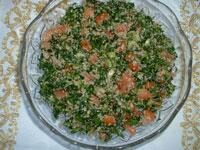U.S. Census Takes Steps to Count Arab-Americans but Most Would Rather Assimilate
Step into Brooklyn’s Church of the Virgin Mary, with its domed ceilings and marble columns, and it’s like stepping into Lebanon. On Sunday mornings, the cantor sings the liturgy in Arabic, his deep baritone voice echoing off the stone walls of the incense-filled sanctuary. Icons and murals depict Jesus and saints as Middle Easterners with dark olive skin. “It’s like seeing the Bible in color,” says Father Antoine Rizk, who has pastored the church since 2004.
Rizk is an Arab-American, one of the 1.3 million living in the United States (according to the 2000 Census) or 3.5 million (according to the Arab American Institute). Two-thirds of them are professing Christians.
Arab-Americans earn master’s degrees and doctorates at twice the national average, and Arab-American income levels exceed the national average by 20 percent.
The Church of the Virgin Mary is a Melkite (Eastern Rite) Catholic Church. Its services in English and Arabic draw parishioners who come from Syria, Lebanon, Egypt, and Palestinian territories. Rizk talks wistfully about the village in Lebanon where he grew up: Machghara was half Christian and half Muslim, and the two communities lived peacefully together.
“My father’s best and oldest friends are Muslim,” Rizk said. “At Christmas and at Easter, Muslim friends came to our homes. During Ramadan, we went to their homes.” Following the outbreak of the Lebanese Civil War in the 1970s, most of the Christians left Machghara, which—like many formerly Christian areas of the Middle East—is now almost exclusively Muslim.
Rizk studied for the priesthood at the Monastery of the Holy Savior in southern Lebanon. Before Lebanon’s civil war, Holy Savior was a thriving mission with 50 priests and students, but when he arrived in 1990, only three priests and six students were in residence. Muslim militias had occupied the monastery during the war, and Israeli bombs had destroyed the top floor of the monastery. As a novice, Rizk helped repair the damaged building.
At the Church of the Virgin Mary, parishioners hold differing views on the Middle East, but political discussion is confined to coffee hour. One Palestinian member passionately described the conditions of his family in Galilee, but when he entered the sanctuary, he became silent. “Politics stops here,” he said.
But politicians don’t want to be silent about the Arab-American vote: Because Arab-Americans vote at a rate of 90 percent in national elections, both Republicans and Democrats covet their support. They voted for former President George W. Bush by a 2 to 1 margin in 2000. In 2008, they voted for President Barack Obama by a similar margin.
Eighty-five percent of Arab-American Christians are either Roman Catholic or Eastern Orthodox, and the Church of the Virgin Mary is a bridge between these communions. Melkite Catholics are in full communion with Rome, but they use Eastern Orthodox rites, object to the term “papal infallibility,” and have always permitted a married clergy. Rizk serves communion to both Catholic and Orthodox Christians, and on Wednesdays his church participates in ecumenical prayer services with Catholic and Orthodox congregations. Such meetings were “unthinkable” 10 years ago, he said.
Arab-Americans claim that the U.S. Census undercounts them because the “ethnicity” section of the census questionnaire does not list them, as it does Asians, Hispanics, and Blacks. In the 2000 census, 80 percent of Arab-Americans identified themselves as “white” and 17 percent as “other.”
For the 2010 census, the U.S. Census Bureau has hired 50 Arabic speakers to encourage the participation of New York’s 450,000 Arab-Americans. But it won’t be easy. Following 9/11, Arab-Americans suffered random acts of violence and they were subject to intense government scrutiny. “This is not a time to have an Arab-American category on any government form,” said demographer Samia El-Badry. The census has a box for “White,” said El-Badry, “and that is where we fit in.”
Robert Carle
WorldMagazine.com


